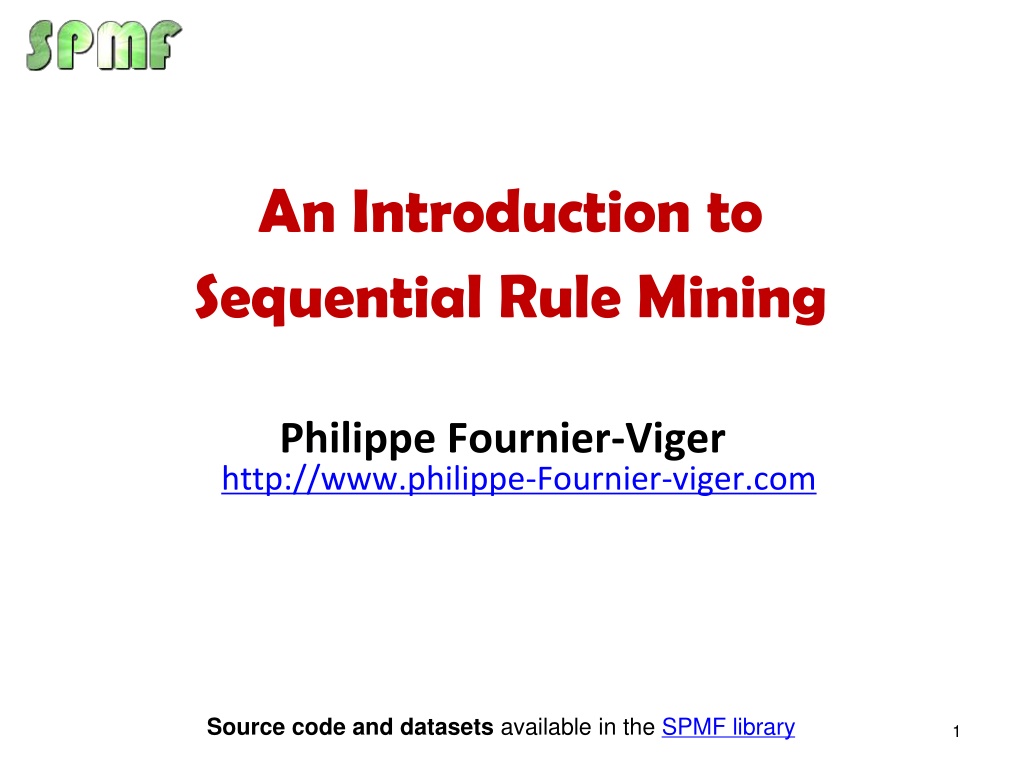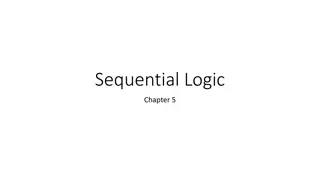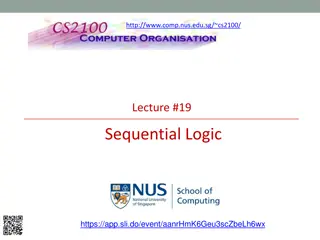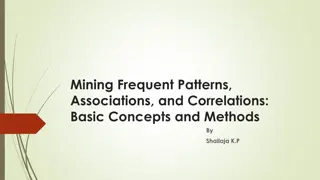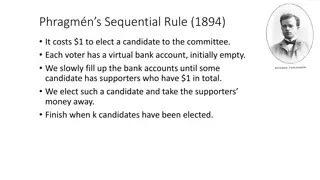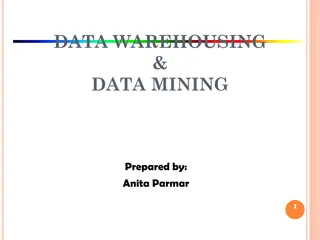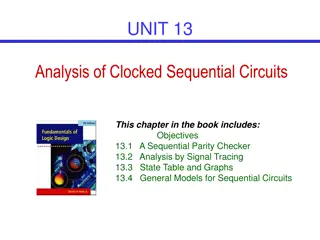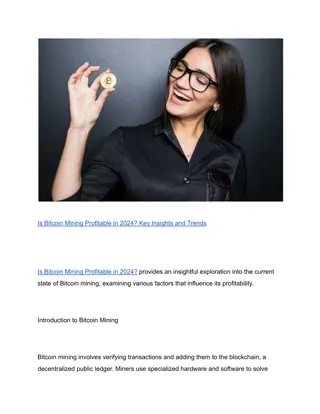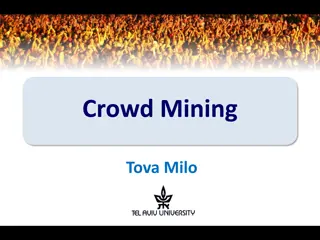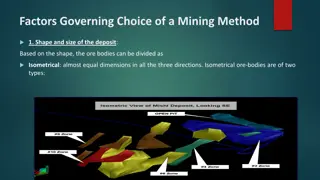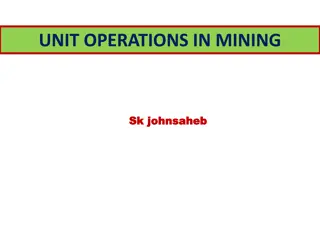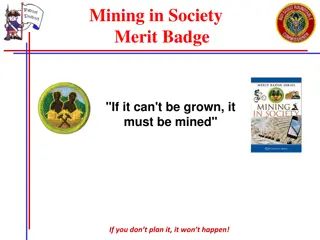Sequential Rule Mining Concepts
Explore the fundamentals of sequential rule mining including discrete sequences, itemsets, and sequence databases. Learn how algorithms are used to discover interesting patterns in sequences, with examples illustrating the process.
Download Presentation

Please find below an Image/Link to download the presentation.
The content on the website is provided AS IS for your information and personal use only. It may not be sold, licensed, or shared on other websites without obtaining consent from the author. Download presentation by click this link. If you encounter any issues during the download, it is possible that the publisher has removed the file from their server.
E N D
Presentation Transcript
An Introduction to Sequential Rule Mining Philippe Fournier-Viger http://www.philippe-Fournier-viger.com Source code and datasets available in the SPMF library 1
Introduction More and more data! A need to analyze data to find interesting patterns Pattern mining: using algorithms to find interesting patterns in data. An important type of data is sequences. Today, we will discuss how to analyze sequences to find sequential rules. 2
What is a discrete sequence? Sequence: an ordered list of symbols Sequence of purchases Computer Monitor Router Sequence of words you going? Where are 3
What is a discrete sequence? Sequence: an ordered list of symbols Sequences of webpage clicks Webpage B Webpage A Webpage C Sequences of activities Watching movies Home Visit museum 4
Definition: Items Let there be a set of items (symbols) called ?. Example: ? = {?,?,?,?,?,?,?} ? = apple ? = dattes ? = bread ? = eggs ? = cake ? = fish ? = grapes 5
Definition: Itemset An itemset is a set of items that is a subset of ?. Example: {?,?,?} is an itemset containing 3 items {?,?} is an itemset containing 2 items Note: an itemset cannot contain a same item twice. An itemset having ? items is called a k-itemset. 6
Definition: Sequence A discrete sequence ? is a an ordered list of itemsets ? = ?1,?2, ,?? where ?? ? for any ? {1,2..?} Example 1: ?,? , ? is a sequence containing two itemsets. It means that a customer purchased ????? and ????? at the same time and then purchased ????. Example 2: ? , ? ,{?} 7
Definition: Sequence Database A sequence database is one or more sequences. SID 1 2 3 4 sequence <{a}, {a,b,c} {a, c} {d} {c, f}> <{a, d}, {c} {b, c} {a, e}> <{e, f}, {a, b} {d, f} {c}, {b}> <{e}, {g}, {a, f} {c} {b}, {c}> Here we have four sequences. Each sequence has a unique sequence identifier (SID) 8
Sequential pattern mining It is a popular data mining task, where the goal is to find sequential patterns. SID 1 2 3 4 sequence <{a}, {a,b,c} {a, c} {d} {c, f}> <{a, d}, {c} {b, c} {a, e}> <{e, f}, {a, b} {d, f} {c}, {b}> <{e}, {g}, {a, f} {c} {b}, {c}> 9
Sequential pattern mining Sequential pattern: a subsequence that appear in many sequences of a sequence database SID 1 2 3 4 sequence <{a}, {a,b,c} {a, c} {d} {c, f}> <{a, d}, {c} {b, c} {a, e}> <{e, f}, {a, b} {d, f} {c}, {b}> <{e}, {g}, {a, f} {c} {b}, {c}> <{a},{f}> is a sequential pattern 10
Sequential pattern mining Sequential pattern: a subsequence that appear in many sequences of a sequence database SID 1 2 3 4 sequence <{a}, {a,b,c} {a, c} {d} {c, f}> <{a, d}, {c} {b, c} {a, e}> <{e, f}, {a, b} {d, f} {c}, {b}> <{e}, {g}, {a, f} {c} {b}, {c}> <{a},{f}> is a sequential pattern Its support is 50% (it appears in 50% of the sequences). 11
Sequential pattern mining Input: A sequence database (a set of sequences) A minsupthreshold Output: All subsequences having a support greater or equal to minsup. Example: minsup = 50 % (2 sequences) A sequence database Sequential patterns IFD sequence Pattern support 1 <{a}, {a,b,c} {a, c} {d} {c, f}> {a} 100 % 2 <{a, d}, {c} {b, c} {a, e}> <{a}, {b,c} > 50 % 3 <{e, f}, {a, b} {d, f} {c}, {b}> <{a, b} > 50 % 4 <{e}, {g}, {a, f} {c} {b}, {c}> Fournier-Viger, P., Lin, J. C.-W., Kiran, R. U., Koh, Y. S., Thomas, R. (2017). A Survey of Sequential Pattern Mining. Data Science and Pattern Recognition (DSPR), vol. 1(1), pp. 54-77.
Some popular algorithms GSP: R. Agrawal, and R. Srikant, Mining sequential patterns, ICDE 1995, pp. 3 14, 1995. SPAM: Ayres, J. Flannick, J. Gehrke, and T. Yiu, Sequential pattern mining using a bitmap representation, KDD 2002, pp. 429 435, 2002. SPADE: M. J. Zaki, SPADE: An efficient algorithm for mining frequent sequences, Machine learning, vol. 42(1-2), pp. 31 60, 2001. PrefixSpan: J. Pei, et al. Mining sequential patterns by pattern-growth: The prefixspan approach, IEEE Transactions on knowledge and data engineering, vol. 16(11), pp. 1424 1440, 2004. CM-SPAM and CM-SPADE: P. Fournier-Viger, A. Gomariz, M. Campos, and R. Thomas, Fast Vertical Mining of Sequential Patterns Using Co-occurrence Information, PAKDD 2014, pp. 40 52, 2014. They all have the same input and output. The difference is performance due to optimizations, search strategies and data structures! Fast implementations available in the SPMF library 13
But there is a problem Sequential pattern mining Let look at the pattern <{a},{f}> We might think that if someone buys a , he will he buy f afterward. SID 1 2 3 4 sequence <{a}, {a,b,c} {a, c} {d} {c, f}> <{a, d}, {c} {b, c} {a, e}> <{e, f}, {a, b} {d, f} {c}, {b}> <{e}, {g}, {a, f} {c} {b}, {c}> 14
But there is a problem Let look at the pattern <{a},{f}> We might think that if someone buys a , he will he buy f afterward. Sequential patterns: a subsequence that appear in many sequences of a sequence database No Only 50% of the time! SID 1 2 3 4 sequence <{a}, {a,b,c} {a, c} {d} {c, f}> <{a, d}, {c} {b, c} {a, e}> <{e, f}, {a, b} {d, f} {c}, {b}> <{e}, {g}, {a, f} {c} {b}, {c}> Thus, sequential patterns can be misleading! 15
How to address this problem? We would like to find patterns that have the form of rules. We want to measure the confidence (probability) that some item(s) will follow some other item(s). Solution: finding sequential rules 75% Watching movies Restaurant 16
Two main types of sequential rules 1) Standard Sequential rules 2) Partially-ordered Sequential rules 17
1) Standard Sequential rules Standard Sequential rules: Rules of the form ? ?, where X and Y are sequential patterns. Example: <{a}, {b,c}> <{d}, {e}> 18
1) Standard Sequential rules Standard Sequential rules: Rules of the form ? ?, where X and Y are sequential patterns. Example: <{a}, {b,c}> <{d}, {e}> Several algorithms to find this type of rules such as RuleGen (Zaki,2001). Main idea: find sequential patterns and then combine them to make rules. 19
1) Standard Sequential rules Standard Sequential rules: Rules of the form ? ?, where X and Y are sequential patterns. Example: <{a}, {b,c}> <{d}, {e}> Two thresholds must be set by the user: minimum support > 0 minimum confidence > 0 Support: how many sequences contain a rule Confidence: how many sequences contain a rule divided by how many sequences contain its antecedent 20
1) Standard Sequential rules Example: <{a}, {b}> <{f}> Support: 1 sequences (25%) Confidence: 1 / 4 = 0.25 (25%) SID 1 2 3 4 sequence <{a}, {a,b,c} {a, c} {d} {c, f}> <{a, d}, {c} {b, c} {a, e}> <{e, f}, {a, b} {d, f} {c}, {b}> <{e}, {g}, {a, f} {c} {b}, {c}> 21
But there is a problem We may find some sequential rules that are very similar but have only some small ordering variations. For example: Rule <{a}, {b}> <{f}> <{b}, {a}> <{f}> Support 25% 25% Confidence 25% 50% These rules may actually represent the same situation! 22
2) Partially-Ordered Sequential rules Partially-Ordered Sequential rules: Rules of the form ? ?, where X and Y are itemsets that are unordered. Example: {a,b} {f} 23
2) Partially-Ordered Sequential rules Partially-Ordered Sequential rules: Rules of the form ? ?, where X and Y are itemsets that are unordered. Example: {a,b} {f} Interpretation: If we observe a and f (in any order), they will be followed by f. 24
2) Partially-Ordered Sequential rules This type of rule is often more interesting because it can summarize many standard sequential rules. For example: Standard sequential rules Partially-ordered sequential rules 25
2) Partially-Ordered Sequential rules A partially-ordered sequential rule X Y is a relationship between two disjoint and non empty itemsets X,Y. A sequential rule X Y has two properties: Support: the number of sequences where X occurs before Y, divided by the number of sequences. Confidence the number of sequences where X occurs before Y, divided by the number of sequences where X occurs. The task: finding all valid rules, rules with a support and confidence not less than user-defined thresholds minSup and minConf (Fournier-Viger, 2010). 26
An example of Sequential Rule Mining Let say that minSup= 0.5 and minConf= 0.5: A sequence database Some rules found 27
Several algorithms CMRules, RuleGrowth, ERMiner: find all the sequential rules TRuleGrowth: find sequential rules with a window constraint TopSeqRules: find the top-k sequential rules TNS: find top-k non-redundant sequential rules HUSRM: find high utility sequential rules These algorithms directly find the rules! 28
Some applications E-learning Fournier-Viger, P., Faghihi, U., Nkambou, R., Mephu Nguifo, E.: CMRules: Mining Sequential Rules Common to Several Sequences. Knowledge- based Systems, Elsevier, 25(1): 63-76 (2012) Toussaint, Ben-Manson, and Vanda Luengo. Mining surgery phase-related sequential rules from vertebroplasty simulations traces. Artificial Intelligence in Medicine. Springer International Publishing, 2015. 35-46. Faghihi, Usef, Philippe Fournier-Viger, and Roger Nkambou. CELTS: A Cognitive Tutoring Agent with Human-Like Learning Capabilities and Emotions. Intelligent and Adaptive Educational- Learning Systems. Springer Berlin Heidelberg, 2013. 339-365. 29
Some applications Manufacturing simulation Kamsu-Foguem, B., Rigal, F., Mauget, F.: Mining association rules for the quality improvement of the production process. Expert Systems and Applications 40(4), 1034-1045 (2012) Quality control Bogon, T., Timm, I. J., Lattner, A. D., Paraskevopoulos, D., Jessen, U., Schmitz, M., Wenzel, S., Spieckermann, S.: Towards Assisted Input and Output Data Analysis in Manufacturing Simulation: The EDASIM Approach. In: Proc. 2012 Winter Simulation Conference, pp. 257 269 (2012) 30
Some applications Web page prefetching Fournier-Viger, P. Gueniche, T., Tseng, V.S.: Using Partially-Ordered Sequential Rules to Generate More Accurate Sequence Prediction. Proc. 8th International Conference on Advanced Data Mining and Applications, pp. 431-442, Springer (2012) Anti-pattern detection in service based systems, Nayrolles, M., Moha, N., Valtchev, P.: Improving SOA antipatterns detection in Service Based Systems by mining execution traces. In: Proc. 20th IEEE Working Conference on Reverse Engineering, pp. 321-330 (2013) Embedded systems Leneve, O., Berges, M., Noh, H. Y.: Exploring Sequential and Association Rule Mining for Pattern-based Energy Demand Characterization. In: Proc. 5th ACM Workshop on Embedded Systems For Energy-Efficient Buildings. ACM, pp. 1 2 (2013) 31
Some applications Alarm sequence analysis Celebi, O.F., Zeydan, E., Ari, I., Ileri, O., Ergut, S.: Alarm Sequence Rule Mining Extended With A Time Confidence Parameter. In: Proc. 14th Industrial Conference on Data Mining (2014) Ileri, Omer, and Salih Erg t. Alarm Sequence Rule Mining Extended With A Time Confidence Parameter. (2014). Recommendation Jannach, Dietmar, and Simon Fischer. Recommendation- based modeling support for data mining processes. Proceedings of the 8th ACM Conference on Recommender systems. ACM, 2014. 32
Some applications Restaurant recommendation Han, M., Wang, Z., Yuan, J.: Mining Constraint Based Sequential Patterns and Rules on Restaurant Recommendation System. Journal of Computational Information Systems 9(10), 3901-3908 (2013) Customer behavior analysis Noughabi, Elham Akhond Zadeh, Amir Albadvi, and Behrouz Homayoun Far. How Can We Explore Patterns of Customer Segments Structural Changes? A Sequential Rule Mining Approach. Information Reuse and Integration (IRI), 2015 IEEE International Conference on. IEEE, 2015. 33
Conclusion Today, I have introduced sequential rule mining. An important topic in pattern mining. Sometimes also called temporal association rule mining or episode rules. There are also other variations. Source code and dataset in the SPMF library 34
Running an algorithm Discovered patterns 35 http://www.philippe-fournier-viger.com/spmf/
